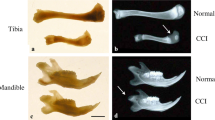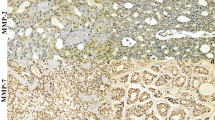Abstract
Cartilage-derived morphogenic protein (CDMP)-1 and -2 belong to the bone morphogenetic protein (BMP) family in the transforming growth factor (TGF)-β superfamily. CDMP-1 and CDMP-2 were reported to play essential roles in limb cartilage and limb-joint formation in developing mice. Although pleomorphic adenoma of the salivary glands is an epithelial tumor, it frequently shows ectopic cartilaginous formation. These findings suggested that CDMP-1 and -2 may play essential roles in chondroid formation in salivary pleomorphic adenoma. To evaluate this hypothesis, we examined the expression and localization of CDMP-1 and -2 immunohistochemially in 20 normal human salivary glands and 35 pleomorphic adenomas. CDMP-1 was immunolocalized in the striated ducts and the intercalated ducts in the normal salivary glands. CDMP-1 was immunolocalized in the cuboidal neoplastic myoepithelial cells around the chondroid areas of the pleomorphic adenomas, whereas these molecules were not localized in the spindle-shaped neoplastic myoepithelial cells of the myxoid element or the lacuna cells of the chondroid element in these tumors. CDMP-2 was expressed neither in normal salivary glands nor any of the elements of the pleomorphic adenomas. Type-II collagen and aggrecan were immunolocalized throughout the matrix around the lacuna cells of the chondroid element, whereas type-X collagen was not immunlocalized in any epithelial or stromal elements, including the chondroid elements. Aggrecan was deposited not only on the chondroid matrix, but also on the myxoid stroma and intercellular spaces of the tubulo-glandular structures, whereas chondromodulin-I was deposited on the chondroid matrix. These results indicated that the cuboidal neoplastic myoepithelial cells around the chondroid areas expressed CDMP-1 and suggested that this molecule may play a role in the differentiation of neoplastic myoepithelial cells in pleomorphic adenoma. The phenotype of the lacuna cells was similar to that of mature to upper hypertrophic chondrocytes of the authentic cartilage. In conclusion, pleomorphic adenoma expressed CDMP-1 but not CDMP-2.



Similar content being viewed by others
References
Chang CS, Hoang B, Thomas JT, Vukicevic S, Luyten PF, Ryba JPN, Kozak AC, Reddi AH, Moos M Jr (1994) Cartilage-derived morphogenetic proteins: new members of the transforming growth factor-β superfamily predominantly expressed in long bone during human embryonic development. J Biol Chem 269:28227–28234
Dardick I (1996) Pleomorphic adenoma (benign mixed tumor) (chapter 9). In: Color atlas/text of the salivary gland tumor pathology. Igaku-Shoin Inc, New York, pp 75–92
Erlacher L, McCartney J, Piek E, ten-Dijke P, Yanagishita M, Oppermann H, Luyten FP (1998) Cartilage-derived morphogenetic proteins and osteogenic protein-1 differentially regulate osteogenesis. J Bone Miner Res 13:383–392
Erlacher L, Ng C-K, Ullrich R, Krieger S, Luyten FP (1998) Presence of cartilage-derived morphogenetic proteins in articular cartilage and enhancement of matrix replacement in vitro. Arthritis-Rheum 41:263–273
Folkman J, Klangsburn M (1967) Angiogenic factors. Science 235:442–447
Helder MN, Ozkaynak E, Sampath TK, Luyten FP, Latin V, Oppermann H, Vukicevic S (1995) Expression pattern of osteogenic protein-1 (bone morphogenetic protein-7) in human and mouse development. J Histochem Cytochem 43:1035–1044
Hiraki Y, Tanaka H, Inoue H, Kondo J, Kmizono A, Suzuki F (1991) Molecular cloning of a new class of cartilage-specific matrix, chondromodulin-I, which stimulates growth of cultured chondrocytes. Biochem Biophys Res Commun 175:971–977
Hiraki Y, Inoue H, Iyama K, Kamizono A, Ochiai M, Shukunami C, Iijima S, Suzuki F, Kondo J (1997) Identification of chondromodulin-I as a novel endothelial growth inhibitor: purification and its localization in the avascular zone of epiphyseal cartilage. J Biol Chem 272:32419–32426
Hiraki Y, Kono T, Sato M, Shukunami C, Kondo J (1997) Inhibition of DNA synthesis and tube morphogenesis of cultured vascular endothelial cells by chondromodulin-I. FEBS Lett 425:321–324
Hiraki Y, Mitsui K, Endo N, Takahashi K, Hayami T, Inoue H, Shukunami C, Tokunaga K, Kono T, Yamada M, Takahashi HE, Kondo J (1999) Molecular cloning of human chondromodulin-I, a cartilage-derived growth modulating factor, and its expression in Chinese hamster ovary cells. Eur J Biochem 260:869–878
Hotten GC, Matsumoto T, Kimura M, Bechtold RF, Kron R, Ohara T, Tanaka H, Satoh Y, Okazaki M, Shirai T, Pan H, Kawai S, Pohl JS, Kudo A (1996) Recombinant human growth/differentiation factor 5 stimulates mesenchyme aggregation and chondrogenesis responsible for the skeletal development. Growth Factors 13:65–74
Kusafuka K, Yamaguchi A, Kayano T, Fujuwara M, Takemura T (1998) Expression of bone morphogenetic proteins in salivary pleomorphic adenomas. Virchows Arch 432:247–253
Kusafuka K, Yamaguchi A, Kayano T, Takemura T (1998) Immunohistochemical localization of fibroblast growth factors (FGFs) and FGF receptor-1 in human normal salivary glands and pleomorphic adenomas. J Oral Pathol Med 27:287–292
Kusafuka K, Yamaguchi A, Kayano T, Takemura T (1999) Immunohistochemical localization of bone morphogenetic protein-6 in salivary pleomorphic adenomas. Pathol Int 49:1023–1027
Kusafuka K, Hiraki Y, Shukunami C, Yamaguchi A, Kayano T, Takemura T (2001) Cartilage-specific matrix protein chondormodulin-I is associated with chondroid formation in salivary pleomorphic adenomas: immunohistochemical analysis. Am J Pathol 158:1465–1472
Luo W, Guo C, Zhang J, Chen TL, Wang PY, Vertel BM, Tanzer ML (2000) Aggrecan from start to finish. J Bone Miner Metab 18:51–56
Luyten FP (1997) Cartilage-derived morphogenetic protein-1. Int J Biochem Cell Biol 29:1241–1244
Lyons KM, Pelton RW, Hogan BLM (1989) Patterns of expression of murine Vgr-1 and BMP-2a RNA suggest that transforming growth factor-β-like genes coordinately regulate aspects of embryonic development. Genes Dev 3:1657–1668
Nishitoh H, Ichijo H, Kimura M, Matsumoto T, Makishima F, Yamaguchi A, Yamashita H, Enomoto S, Miyazono K (1996) Identification of type I and type II serine/threonine kinase receptors for growth/differentiation factor-5. J Biol Chem 271:21345–21352
Schmid TM, Popp RG, Linsenmayer TF (1990) Hypertrophic cartilage matrix: type X collagen, supramolecular assembly and calcification. Ann N Y Acad Sci 580:64–73
Schmid TM, Bonen DK, Luchene L, Linsenmayer TF (1991) Late events in chondrocyte differentiation: hypertrophy, type X collagen synthesis and matrix calcification. In Vivo 5:533–540
Shukunami C, Iyama K, Inoue H, Hiraki Y (1999) Spatiotemporal pattern of the mouse chondromodulin-I gene expression and its regulatory role in vascular invasion into cartilage during endochondral bone formation. Int J Dev Biol 43:39–49
Takeda M, Iwata H, Suzuki S, Brown KS, Kimata K (1986) Correction of abnormal matrix formed by cmd/cmd chondrocytes in culture by exogenously added cartilage proteoglycan. J Cell Biol 103:1605–1614
Zhao M, Takata T, Ogawa I, Yada T, Kimata K, Nikai H (1999) Immunohistochemical evaluation of the small and large proteoglycans in pleomorphic adenoma of the salivary glands. J Oral Pathol Med 28:37–42
Acknowledgements
We are grateful to Susumu Sekiguchi, Kikuo Wakamatsu, Shoichi Hashimoto, Akira Niizeki, Hiroko Komatsuzaki and Eiji Shimada on the staff of the Department of Pathology, Japanese Red Cross Medical Center, Tokyo, Japan, for technical assistance. We wish to thank Mr. Takashi Yoshizawa at the Photo Studio, Tokyo Medical and Dental University, Tokyo, Japan, for microphotography. We also wish to thank Drs. Toshikazu Yada and Koji Kimata (Institute for Molecular Science of Medicine, Aichi Medical University, Nagoya, Japan) for generously providing specific antibody against aggrecan.
Author information
Authors and Affiliations
Corresponding author
Rights and permissions
About this article
Cite this article
Kusafuka, K., Luyten, F.P., De Bondt, R. et al. Immunohistochemical evaluation of cartilage-derived morphogenic protein-1 and -2 in normal human salivary glands and pleomorphic adenomas. Virchows Arch 442, 482–490 (2003). https://doi.org/10.1007/s00428-003-0761-y
Received:
Accepted:
Published:
Issue Date:
DOI: https://doi.org/10.1007/s00428-003-0761-y




